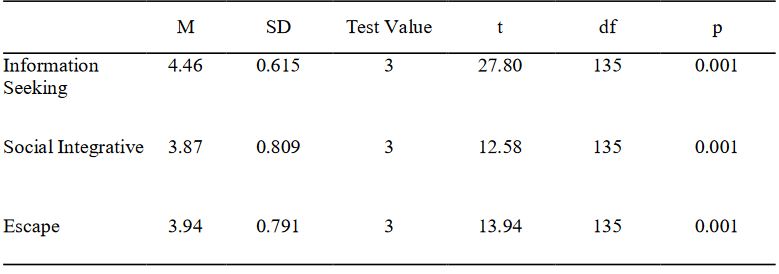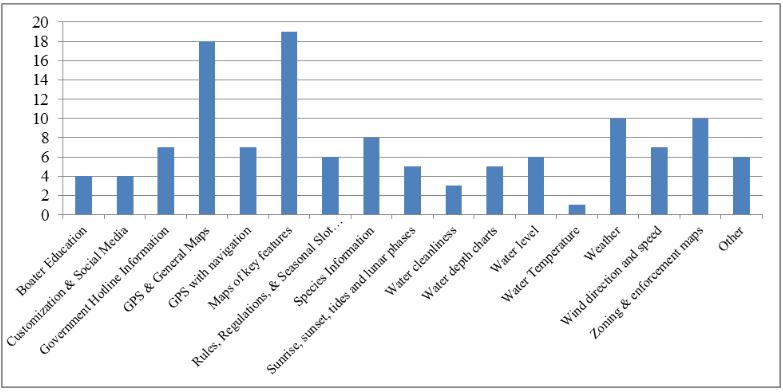ABSTRACT
The purpose of this study was to understand boaters’ adoption and usage of smartphones and mobile apps as well as to obtain their opinion on potential features of a targeted mobile app being developed as part of a broader interdisciplinary Florida Sea Grant outreach project. Data were gathered from an online survey of a sample of 164 boaters from the surrounding Central Florida area.
In contrast with previous empirical mobile app studies, many respondents reported using mobile apps for information-seeking versus escape gratifications. Further more than half of the respondents’ age sixty-five and over indicated using smartphones and mobile apps. These findings reflected recent national trend data showing shifting gratifications and an increase in technology use among older American adults. In regards to the planned mobile app, the study’s respondents had favorable reactions to its potential features and indicated an above average intent to ward downloading the app.
REVIEW OF LITERATURE
Diffusion of Smartphones and Mobile Apps
Diffusion of Innovations (DOI) has been deemed as a useful theory to understand how an innovation is adopted within a society (Im & Ha, 2012; Lin, 2001; Rogers, 1995). The theory has been applied to understand the diffusion of other technologies similar to smartphones and mobile apps including personal computers (Lin, 1998) and mobile gaming (Schuurman, Courtois, & De Marez, 2011). An innovation can be defined as anything perceived as new to an individual. Whether the innovation is an idea, a product, a technology, or a tool, it follows a similar pattern of adoption; however, the time it takes for an innovation to be adopted can vary based on two factors: the technology’s attributes and the individual’s attributes (Rogers, 1995).
METHOD
To determine the desired features of the mobile app, each coded response was first placed into the following six categories: 1) area conditions, which relates to weather and water conditions at Mosquito Lagoon; 2) navigation, which relates to features that will help guide boaters at the Lagoon; 3) customization and social media, which relates to being able to customize the mobile app and socialize with friends; 4) fishing regulations, which relates to boating rules and regulations, and contact information and website links to regulatory agencies that manage the Lagoon; 5) educational information, which relates to information that could be used to educate boaters about the area; and 6) other, which represented information that did not fit into any of the specified categories (for frequencies see Figure 1).
RESULTS

Table 1 Results of One-Sample t-test for Mobile App Gratifications
The fourth set of research questions were based on the uses (RQ4a) and gratifications (RQ4 b) that boaters receive from mobile apps. For RQ4 a, the respondents indicated using mobile apps to find information on news, weather, sports, or stock updates (96.3%), to access the internet (90.4%), and to get directions (86%). For mobile app gratifications (RQ4 b), a one-sample t-test (see Table 1) revealed that the respondents use mobile apps for: information-seeking needs (M = 4.46, SD = .615); followed by escape needs (M = 3.94, SD = .791); and social integrative needs (M = 3.87, SD = .809).
DISCUSSION
This study set out to provide a better understanding of boater’s attitudes toward and uses of mobile technology in order to advance knowledge on the role of new technology in this understudied context. Specifically, the purpose of this study was: (1) to determine the current adoption rate and barriers to the adoption of smartphones, mobile apps, and map-based LBS apps within the targeted population; (2) to explore the uses and gratifications of mobile apps and map-based LBS apps among those within the targeted population who are already smartphone adopters, (3) to identify what features of the planned Mosquito Lagoon mobile app the target audience would find most useful while boating; and (4) to assess whether the perceived usefulness of the planned mobile app’s features would increase their adoption intention. It also aimed to provide practical guidance for the development of a planned targeted mobile app for the broader Florida Sea Grant project and for environmental social marketing campaigns looking to incorporate targeted mobile apps into their overall campaign strategy.
CONCLUSION
Smartphones and mobile apps have advanced both in terms of technological capabilities and the number of adopters from just a few years ago. As costs continue to decrease and the available features increase, there will soon be a smartphone and a mobile app for (or at least 69 available to) a large percentage of the American adult population. Further, as more and more developers create mobile apps and the market growth expectations rise, understanding what the audience wants or needs from their mobile apps will become increasingly important.
The results of this study provided a glimpse into a small subset of the population. While this study was exploratory in nature and is limited in generalizability, many of the findings (barriers and common uses) were consistent with the results from previous empirical research.
The study also provided the researcher with some interesting results which seem in line with new survey data from the Pew Internet Research Center. For example, Purcell (2011b) found that a shift is occurring where more American adults look for mobile apps to fulfill their information-seeking versus escape needs. The results from the study also suggest that respondents also look to mobile apps to fulfill their information-seeking versus escape needs from mobile apps.
Source: University of Central Florida
Author: Kamra Bowerman
